I have been trading cryptocurrencies for 10 years, and professionally for 6 years, spanning over 1800 days. Starting with a capital of 200,000, I have experienced various pressures, pains, and confusions over the years. Ultimately, I achieved great insights, simplified my trading techniques, and in just three years, easily withdrew 48 million from the crypto space!
Achieving continuous and stable profits to support my family with cryptocurrency! I have currently made profits equivalent to a house in Shenzhen, a car, and some savings and assets.
I have tried long-term, short-term, ultra-short, and swing trading; I have practiced nearly every type of method.

In the crypto space, many friends may not know how to interpret K-line trading strategies, and few understand the details and technical patterns. As the saying goes, mastering one skill can lead to success everywhere. It’s not difficult to master a technique that you can understand; the difficulty lies in the unwillingness to learn. Trading cryptocurrencies is not for others but for yourself. If you are willing to put in more effort to learn and master it, trading cryptocurrencies won’t be as hard as you imagine.
Today, I will teach you a rolling position strategy with a win rate of up to 90%.
I have used this method successfully for many years, and it is still a strategy I frequently employ.
Next, I will break down rolling positions in detail; this road is for ordinary people. You can only operate this way if you have made two to three times your spot profit without caring about losses.
That said... the bigger the waves, the more valuable the fish 😂
[Use spare money! Use spare money! Don’t get carried away; don’t use non-essential funds for investment.]
Systematic teaching from 0 to 1 to learn the complete version of "rolling positions"👇
01
In the crypto space, rolling positions are usually done by leveraging the spot or futures market to amplify profits.
📍The crypto trading world has created many legendary stories.
For example, the semi-god of the crypto space, "Ban Mu Xia": a low-risk trading strategy quickly turned 10,000 into 4 million. "Sloth Bitcoin": in 3 years, grew from over 1 million to 200 million using a trading strategy that quickly turned 1 million into 200 million. Their success involves a trading strategy—rolling positions.
Steps for rolling positions:
1. Choose a target: Select a cryptocurrency that you believe will rise in the future.
2. First purchase: Use all your funds to buy that cryptocurrency.
3. Set a stop-loss: Set a stop-loss below the purchase price to limit your losses.
4. Monitor the market: Continuously monitor market trends.
5. When the price rises: If the price rises to the preset target, use part of the profits to increase the stake and buy more.
6. Repeat steps 4 and 5: Continue to monitor the market and increase the stake when the price rises.
Many people believe that rolling positions carry high risks, but compared to opening futures positions, the risks are actually more controllable.
Next, we will teach from a practical perspective.
02
Understanding rolling positions through case studies.
Bitcoin 2020-2021 bull market review. From October 2020 to March 2021, Bitcoin rose from $10,000 to $60,000. Taking this market as an example, we review how rolling positions helped funds grow rapidly.
This is a one-sided upward trend in a bull market. We will review the rolling positions during this period, focusing on how to effectively roll positions to achieve rapid compound growth of funds.
First entry (Figure 1)
At the K-line at the position indicated by the arrow in the lower diagram, we can see that after a period of medium to long-term fluctuations, Bitcoin has formed a converging triangle structure. At this position, a large upward candle broke through the upper descending trend line, sending us a bullish signal.
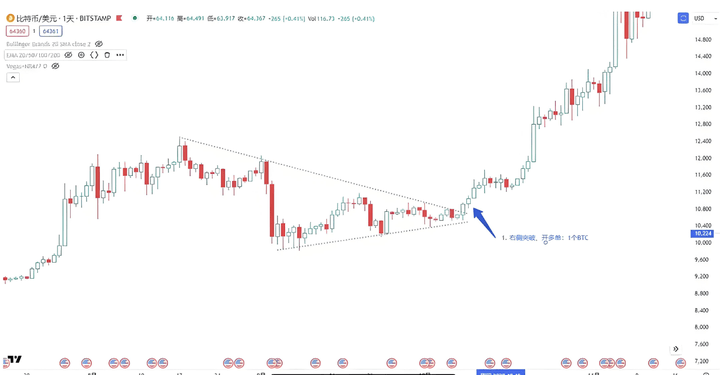
A breakout of the right side of the converging triangle signals a bullish trend.
Therefore, at the position indicated by the arrow, when BTC signals a bullish trend on the right side, we can track the breakout on the right side, assuming we opened a long position in BTC at that time.
Second entry (Figure 2)
The subsequent market entered a very strong upward trend. At the position indicated by the mouse, we can see that Bitcoin formed a converging pattern of an ascending triangle.
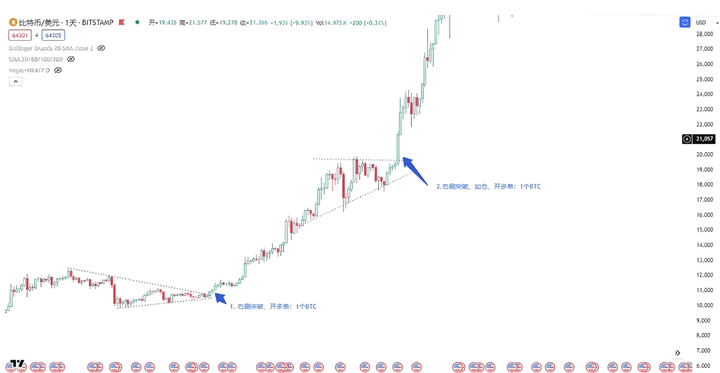
(Figure 3) At this position, it is exactly the right time as defined by the sloth trader, which is the time to roll positions, located at the point indicated by arrow 2. If we pursue the breakout on the right side at this position and open a long position in BTC, we can see that Bitcoin broke through previous highs with a large upward candle after several medium to long-term fluctuations. This position adheres to the three key strategies of the sloth trader: right-side trading, chasing breakouts, and increasing positions on floating profits.
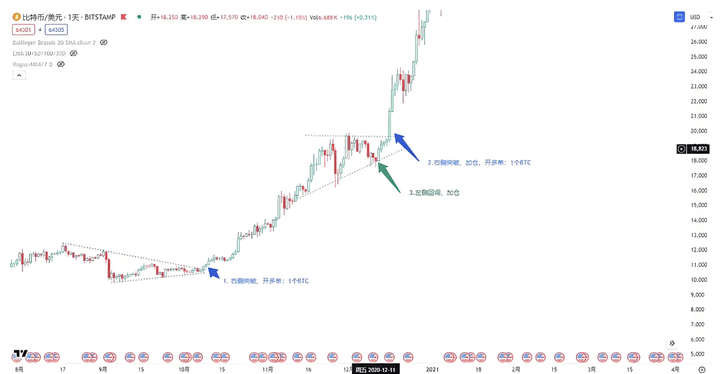
Additionally, at the position indicated by arrow 2, a converging triangle was formed, and there is also a position for increasing the stake, which is at the location indicated by arrow 3.
We can regard this as the support point of the upward trend line. At this position, according to the strategy defined by the sloth trader, increasing the stake during a pullback is feasible. When the price drops near the upward trend line and forms a small-bodied candlestick, followed by a large upward candle, this is also an opportunity to increase positions, as well as part of the rolling process.
03
(Figure 1) Reviewing our previous two entries, suppose our K-line has evolved to the position before a large pullback, with a price of about 40518. At this time, we can see that the floating profit increase at point 2 (rolling positions) has increased by 101%.
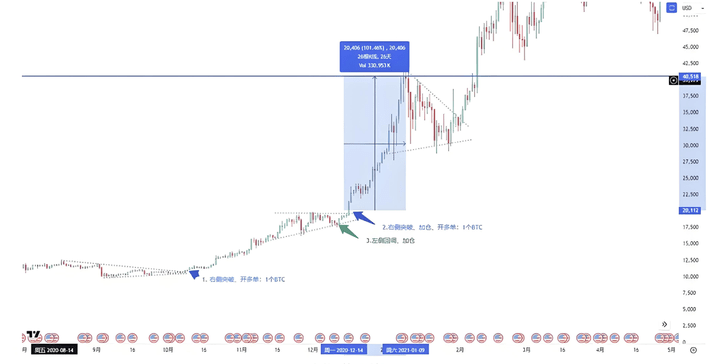
(Figure 2) If the long position at point 1 had been held all the way to this position, its increase would have been 261%.
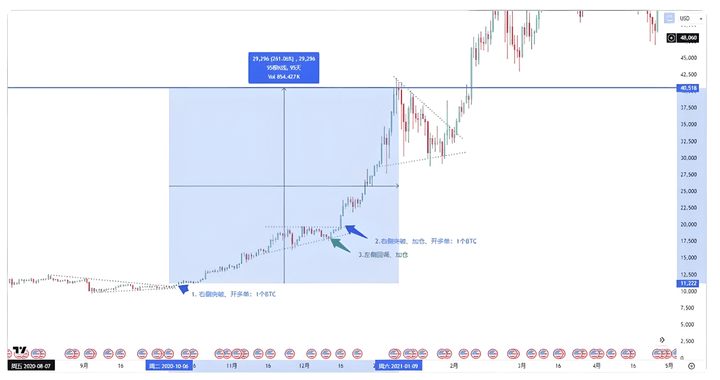
After completing the rolling operation, the long trade at point 2 has captured the main upward wave that followed. When the price reaches a phase resistance position, this part of the position can be quickly reduced. In other words, you can directly close the BTC long position at point 2 at the retracement position of 40518.
04
Third opportunity to increase the stake.
Looking back from the price of 40518, we find that there are also opportunities for rolling positions that appear afterward. As shown in the diagram, point 4 is a position suitable for rolling positions on the right-side breakout. Similarly, point 5 is a left-side pullback position for increasing the stake (similar to the previous point 3, left-side increases have a better risk-reward ratio).
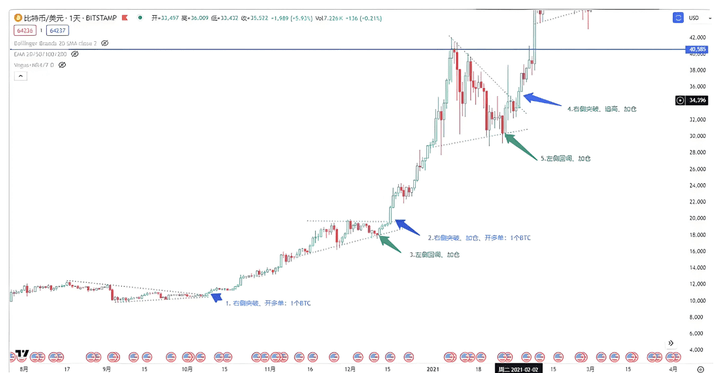
Rolling positions using left-side trading strategies at points 3 and 5 further tests the trader's skill level.
When buying at a low point or at a moving average, it is essential to combine more indicators or strategy signals as the basis for trading.
For example: We can open a medium-term moving average at the daily level, namely MA30. At arrow 3, we can see it is at the support level of the first converging triangle, while a bullish candle has formed, and it stands above the daily MA30. Thus, this position can serve as a judgment basis.
Similarly, at arrow 5, if we open the Fibonacci retracement of the previous ascending trend, we can see that the low of the candlestick at position 5 has basically retraced to the 0.5 level of the previous upward trend. This means that once the upward trend is confirmed, secondary retracements to 0.5 or even the extreme 0.618 are very important positions. After forming a bullish candle here, position 5 can also be seen as a suitable place for rolling positions.
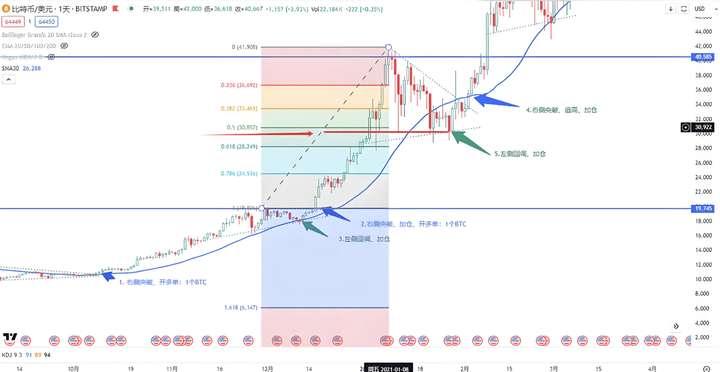
Next, at position 6, we can see a large upward candle breaking through the previous high, which is a suitable position for rolling positions.
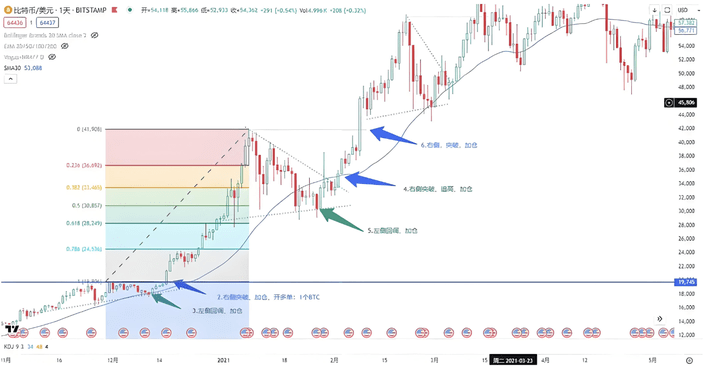
Subsequently, the market reached position 7.
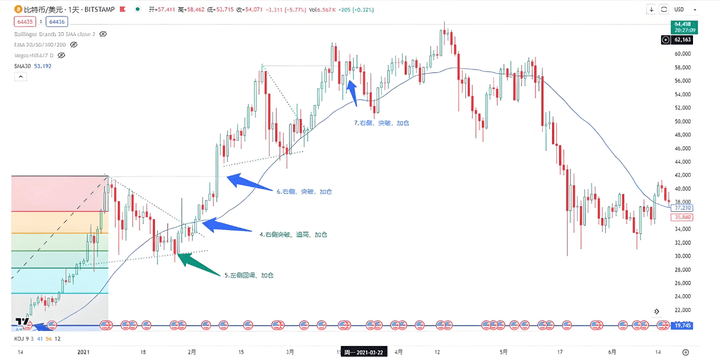
On this day, a large upward candle first broke through the previous high. Therefore, at position 7, we can use it as a basis for rolling positions in right-side trading.
After the large upward candle closed, chasing the breakout was a reasonable choice. However, as we later see, the breakout at position 7 was actually a false breakout. If we had rolled positions at position 7, subsequent signals indicate that this operation failed. Even if a high point formed again after position 7 and a breakout occurred, it subsequently fell again, which was also a false breakout.
Therefore, if we rolled positions based on position 7 and the subsequent signals, this rolling operation would have failed.
05
Suppose you only have 50,000; how can you use this money to start your investment journey?
First, this 50,000 should be your profit; if you are still in the red, don’t rush to look further.
If you buy Bitcoin at a price of 10,000 and set a 10x leverage, using a position of only 10%, that is, using only 5,000 as margin. This is equivalent to using 1x leverage and setting a 2% stop-loss; even if the stop-loss is triggered, you will only lose 2%, which is 1,000. How do those who get liquidated end up in that situation? Even if you get liquidated, haven’t you only lost 5,000? How could you lose everything?
If you guessed correctly and Bitcoin rose to 11,000, you would continue to open positions at 10%, still setting a 2% stop-loss; even if triggered, you would still gain 8%.#香港稳定币新规
What about the risk? Isn’t the risk huge?
Following this logic...
If Bitcoin rises to 15,000 and you keep increasing your position, capturing this 50% move, you should be able to earn around 200,000. If you capture two such moves, your account can grow to around 1,000,000.
There is no need for compound interest at all; a 100-fold increase is achieved through two 10-fold increases, three 5-fold increases, or four 3-fold increases, rather than through daily or monthly returns of 10% or 20%. That’s just nonsense.
Rolling positions is not suitable for all cryptocurrencies. Choosing cryptocurrencies with good liquidity and active trading can reduce risks. Do not over-leverage, as this can easily lead to liquidation. Setting stop-loss and take-profit levels can help you control risk and lock in profits.
Stay calm during market fluctuations and avoid making impulsive decisions. If the market is highly volatile, rolling positions is not suitable, as emotions can easily lead to wrong decisions.
Finally, let’s talk about the top 10 mindsets that can help you survive in the crypto space and make big money. I remind all crypto traders to keep these in mind:
1. The standard for judging experts lies in their duration of holding cash: True experts do not just profit when the market is bullish, but importantly, they know to decisively choose to hold cash when the market is unclear or highly risky. This patience and discipline are core elements leading to success.
2. In a bear market, all purchases may be wrong: During a bear market, the overall market trend is downward, so any buying action is very likely to encounter greater declines. Therefore, maintaining a cautious attitude and minimizing trades or not trading at all until the market stabilizes or a bull market arrives is the wisest choice.
3. In a bull market, all sell actions may be wrong: During a bull market, prices continue to rise, and selling too early may lead to missing out on more substantial profits. Persisting in holding and going with the trend is key; only when the market trend shows a clear change should you consider selling.
4. The essence of investment lies in buying low and selling high: It sounds extremely simple, yet it is fraught with difficulties in practice. The core point is to have enough patience to wait for the right entry and exit moments, without being swayed by short-term market fluctuations.
5. The direction of the market is determined by the main funds: The main direction of the market is driven by large-scale funds. Understanding the dynamics of major funds can help us go with the trend and avoid falling into the trap of counter-trend operations.
6. Technical and fundamental aspects cannot compete with the overall trend: Whether it's technical analysis or fundamental analysis, they appear insignificant in the face of the overall market trend. Following the trend is the key to achieving long-term profitability.
7. Bearish signals at the top indicate a bottom; you should sell decisively: When the market is at a high, bearish news often indicates an impending reversal, making it an excellent signal to exit.
8. Bearish signals at the bottom actually indicate a bottom; you need to buy boldly: In the bottom area of the market, bearish news usually reflects extreme panic, and this is precisely the best time to buy.
9. One lifetime of wealth is enough; be sure to protect the riches you have gained: Do not be greedy, know when to take profits at the right time, and firmly guard the money you have earned. This is a key point for achieving long-term success.
10. Bitcoin must be allocated; otherwise, you may not make money in a bull market: As the leader of the cryptocurrency market, Bitcoin often has the most significant price increase during a bull market. Proper allocation of Bitcoin can help us achieve stable returns in a bull market.
These valuable pieces of advice are the crystallization of years of practical experience, worthy of our thoughtful consideration and strict adherence. I hope these suggestions help everyone make fewer detours in the market and steadily move towards success.
No matter how diligent a fisherman is, they will not go out to sea during a storm, but will instead protect their boat. This season will pass, and sunny days will come! Follow Yan An, and he will teach you both how to fish and how to fish sustainably. The door to the crypto world is always open; going with the trend is the way to have a smooth life. Remember this!
